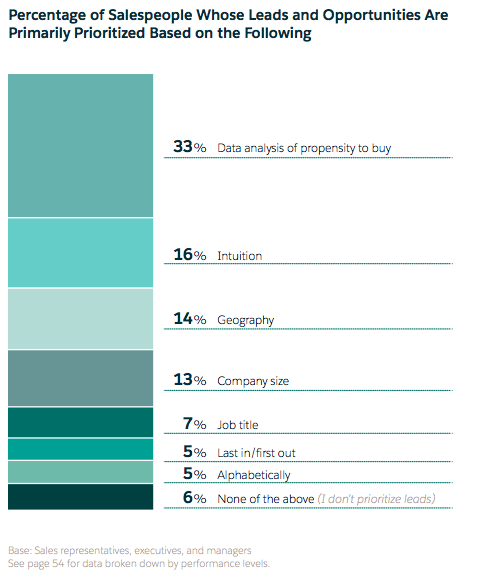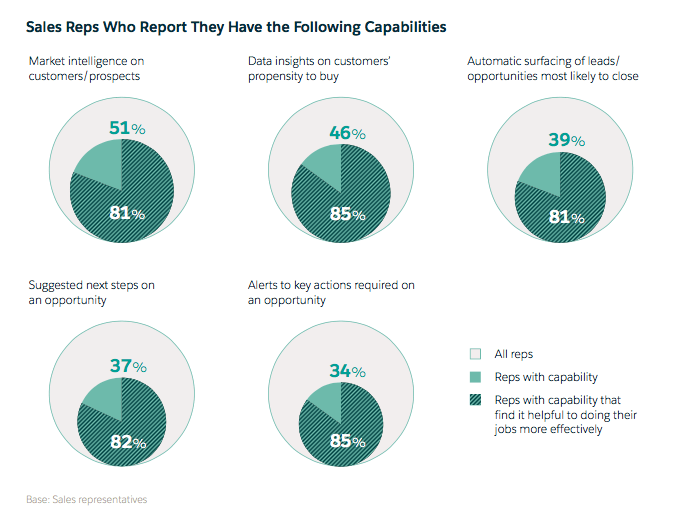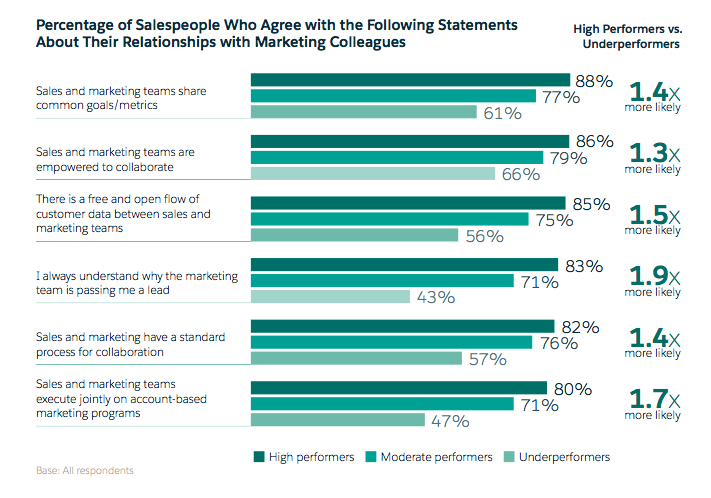Salesforce has long been a market leader in CRM technology, but they’re also pretty good at research and customer support, both of which fuel their overall popularity with sales teams. It’ll be no surprise to anyone that follows Salesforce that the 2018 State of Sales Report brings insight into current selling tactics, technology adoption, and sales trends from 2,908 sales professionals from around the world. It was conducted March-April 2018.
The Salesforce report focuses on 5 main trends across the sales industry:
- Increased customer expectations
- Increased use of data
- Growth and adoption of artificial intelligence (AI) in sales processes
- Movement toward inside sales and virtual sales
- Increased cooperation between sales, marketing, and customer service teams
The report concludes that increased adoption of advanced technologies plus cooperation across customer-facing teams lead to greater sales success. These high performing teams grow faster, sell more, and report higher customer satisfaction rates across the board than their low performing competitors.
Conversely, those who refrain from learning about and adopting the latest technologies and customer-first focuses tend to sell less, grow more slowly, and have a less thorough understanding of how to sell to their customers.
This article breaks down the most interesting (according to us) conclusions from the 2018 State of Sales Report (access the full report here).
Increasing Customer Expectations
It’s a buyer’s market. No longer do buyers’ needs take second place to the sales opportunity, but rather a buyer’s needs drives how the sales process evolves. Much of this change comes from the consumer marketplace’s increased focus on personalization and customer experience. Now, 82 percent of business buyers want the same personalized experience they’ve come to expect from a commercial marketplace, blurring the divisions between how B2B marketers, sellers, and support teams and their B2C counterparts approach the customer journey.
And while customers demand more personalized and involved experiences from sales teams, sales reps only spend about 34 percent of their time selling directly to customers. They use the other ‚Öî of their time to update sales information, prioritize opportunities, email customers and partners, and other administrative, non-selling tasks.

What these findings suggest is that sales teams feel greater pressure than ever to understand their sales prospects better, interact with them personally to close deals, and make happy customers who will come back for repeat business. But an equal and opposite force on these teams is the need to update data manually and produce the types of information and documents that support selling.
Increased Data Usage
The last couple of decades has seen a growing adoption of technologies within the sales field, and with that comes an explosion of sales-related data that companies are just beginning to tap into to drive sales decisions. Only 33 percent of companies use data rather than intuition to understand whether a prospect will buy, with high performing teams 1.6x more likely to tap into their data than their low-performing competitors.

But closing the deal still requires a human touch, and sales teams are prioritizing their time more than ever. Reps are spending less time on tactics that can be covered in a white paper or email like demonstrating ROI and providing customer references, and instead spend their time on soft skills during the close.
So while data is becoming more common and more important for the overall sales process, its current use in forecasting sales goals and curating the customer’s journey through the early and middle stages of the sales pipeline is most important. Sales teams and customers still value the human touch at close for the highest customer satisfaction.
AI
Remember the problem we discussed in the first section? Sales teams need to personalize their efforts and reduce their administrative tasks. If only there were a technology that would facilitate just those changes 🤔. Oh yeah! Artificial intelligence within sales tools can do that!
Sales leaders foresee a massive adoption of AI across all selling by 2020, although only 21 percent of teams currently use the technology. True to the other trends in this report, the high performers are nearly 5x as likely to use AI than low performers.
People want to use the technology that helps make their jobs easier, so if they can save a couple of clicks or hours doing manual data entry, sales leaders are all for implementing technologies that’ll do it. But people are afraid of AI. And the reasons are more complex than a deep-seated fear of the singularity. The disparity between the effectiveness of the tools and how many teams actually use them is striking. Only ‚Öì to ¬Ω of all sales teams use AI, but 80-85 percent of teams who do use these AI features say they help them do their jobs better.

Many teams are afraid that AI will mean fewer sales jobs in the future. These Nervous Nellies can breathe a sigh of relief, however, because 76 percent of companies that have implemented AI in their sales teams have also been growing their sales teams. AI is actually making more jobs than it’s taking because personal (human) insights are still important. AI can suggest but humans still need to take the wheel when it comes to closing the deal.
People know AI technology works to help them sell better, but adoption is still slow. This perhaps points to other underlying barriers to adoption, including lack of training, scarcity of investment capital, and shortage of options that make sense for sales teams of different sizes. As we see higher implementation rates of AI into mainstream and best of breed sales tools, we should also see higher adoption rates by small and midsize sales teams.
Virtual Selling
It’s no surprise that virtual selling is really taking off, given the proliferation of consumer and corporate communication tools that allow reps to connect with customers virtually. Most sales reps spend more time connecting with customers than they did in 2015, but the growth of virtual selling is 3x as robust as in-person selling.
Virtual sales reps still build relationships with customers via virtual meetings on webcast, webinar, VoIP, and video conferencing tools. They also better serve dispersed customer bases and save money on travel by using technology to connect. As a side benefit, teams spend more time together and are more cohesive, meaning they can better align on projects and new initiatives.
Data organization and analysis tools like contact management, CRM, forecasting, training, and email integrations all sit above 50 percent adoption rates within this new virtual workplace. A quickly rising star is the mobile selling app, which holds a 46 percent adoption rate. Not just for the field rep anymore, a mobile selling app helps reps and customers stay connected when and where the customer is ready to do business.
Breaking out of the Silos
Customer experience has grown more important over the last several years as B2B and B2C brands move to greater personalization and incorporate diverse sets of data into how they understand the customer journey. This trend is likely to continue as connected technologies give teams better insights into how customers move across marketing, sales, and support pipelines.
And yet the disparity between understanding value and implementation is still wider than expected: 77 percent of teams see the importance of cross-team selling, but less than 50 percent actually have fully connected technology in place to be able to do this effectively.
Collaboration helps sales and marketing teams improve understanding of high-value prospects and the best targeting practices. High performers are nearly 2x as likely to understand why marketing passed them a lead as low performers.
Interestingly, 80 percent of these high performers are also using the account based marketing (ABM) model. This correlation may have cyclical causes: ABM tactics require sales and marketing teams to work together, which breaks down the silos and turns these teams into better communicators across team lines, which makes them better personalized sellers, which is also good for ABM.

Conclusions
According to this report, the state of sales relies on the adoption of technology, more flexible sales models, and collaboration across teams to improve customer experiences. High performing teams use more technology to streamline their everyday processes so they can spend more time personally closing deals. They also talk with their counterparts in marketing and customer success to better understand where prospects are coming from and what they expect when they move from lead to customer. Low performers are stuck using gut feeling, manual processes, and less sales enablement technology, and therefore have fewer personal interactions where they can close deals.
As we watch these trends develop over the next several years, it will be interesting to see how data and technology usage will continue to shape how sales teams operate both in the office and out.

